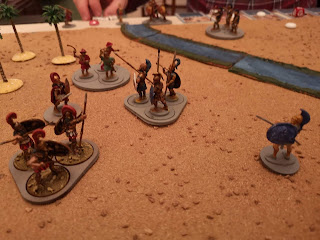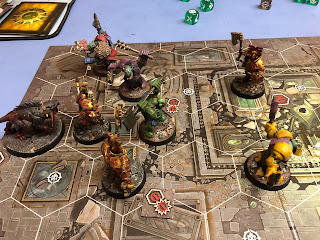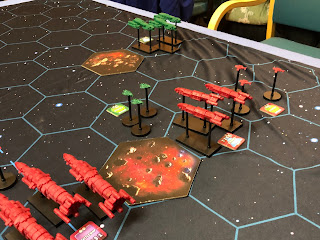So my mate, Alan, has been waiting with fevered anticipation for this to arrive and so when the postie delivered Mortal Gods (originally by a company called "War Banner" but who have now had to change their name to "Dark Peak Games" and then to "Footsore Miniatures and Games" due to having received cease and desist letters from GW and Peak Games - see the announcement here) to him a couple of weeks ago he has been been busy as the proverbial painting up the core set figures. And Alan being Alan, had also got the Spartan and Athenian boxed sets as well as a number of "extra" models so he has gone pretty well all in on the game!
So when I went up to his house last week he had a couple of warbands pretty well all painted and ready to go
All set up and ready for action
Each player creates a Warband with each individual warrior, group of warriors and hero costing a number of points with 300 points being suggested for a reasonable sized game. Each Warband (or "Lochos" to give it it's proper title) is led by a "Lochagos". At least half of the warband's points must be spent on rank and file troops (called "Companions") and for every 125 points spent on the warband, the Lochos can include an additional hero.
The Athenian Lochagos - Andronikos the Defender
Different types of warrior are represented - from your skirmishing troops to your classic Hoplite Warrior and each unit will be classed as either Light, Medium or Heavy representing the armour that those warriors wore.
Each part of the warband will have a stat card showing the various attributes that you need to use throughout the game - movement, attack value, "active" defense value, resistance, courage and activations. Some units may also have "gifts" bestowed on from the Gods - special abilities that can perhaps boost movement or combat or courage.
Stat Card for an Athenian "Peripoloi" unit.
The Brave Defenders of Democracy - the Athenians
The Tyrannical Spartans
The system is activation based. Rank and file units will normally only have 1 activation they can do per game turn with heroes having 2 or more. At the start of a game turn each unit is allocated a token per activation it can do (in the core set you get white pebbles for rank and file and black pebbles for heroes) and these are put in a draw bag and then the player draws a pebble from the bag. If it's white pebble then they can take an action with one of their rank and file units and if it is a black pebble they can take an action with one of their heroes. In the game that we played each of heroes had a special ability whereby they could use their activation to order another of their units within 6" of them, even if that unit had already activated that turn - effectively giving the unit a "free action" - this can come in very handy!
With an activation a unit can either move (Light troops can move up to 8 inches, Medium troops up to 7 inches and Heavy troops up to 6 inches), carry out a charge attack whereby the unit can move it's normal movement plus D6 inches - beware, however, if you roll a "1" on the D6 then your unit is deemed to have "stumbled" and won't then charge! Missile troops can carry out a ranged attack. If a unit has the "form up" gift then it can join up with 2 other similar stands of figures to form a phalanx.(this didn't come up in our game so I don't know what the benefits of forming a phalanx are except to assume that it will be pretty hard in combat! - I'll investigate this in more detail the next time we play!).
Combat involves rolling some custom dice - these are emblazoned with swords, double swords, shield or a "Pegasus" symbol. When attacking, a unit rolls the number of dice as shown on their stat card plus any other bonus dice that they may qualify for through their gifts or some other event. Every sword symbol rolled counts as a success and if a Pegasus symbol is rolled then this may also count as a success if the attack stat on the card has a blue Pegasus symbol next to it.
That's a lot of swords!!!
Before any attack dice are rolled, the defending unit will need to declare if it is "actively defending". If that unit has not yet taken an activation for the turn then it can choose to actively defend (and thus use up it's activation for the turn) thus allowing it to roll the number of defense dice shown on it's stat card. If it chooses not to actively defend - thus hoping to keep it's activation to do something else then it will need to make a courage check - the unit will roll a number of dice as shown on the Courage Stat on it's card. If it rolls a sword symbol - it passes. (I will need to check this time next time I see the rules as it didn't seem very onerous a check - that is until my Lochagos did a courage check and just managed to roll 1 sword on 4 dice!). If the check is passed then the unit will roll defense dice equivalent to it's armour rating, 2 for Heavy troops, 1 for Medium troops and none for Lights!
For every Shield symbol rolled (and if allowed by the Defense Stat - Pegasus Symbols) will cancel one of the successes. If there are still 1 or more successes remaining then the attacker will roll a number of dice equivalent to the uncancelled successes and again each sword symbol will this time score a wound on the defending unit (as marked by the red dice in the Peripoloi picture above). Once a model takes wounds equal to it's resistance value it is removed from play. If damage is scored then the defending unit will be forced to retreat 1 or 2 inches back depending on how much damage is scored. If no successes are scored then the attacking unit will retire an inch.
If a stat symbol has a "Red Pegasus" symbol next to it then that will cause a penalty to the particular unit when using that stat if a Pegasus symbol is rolled. Again note the Red Pegasus symbol next to the defence stat on the Peripoloi card.
In addition to all of the activation peebles placed in the bag are placed 3 red "Omen" pebbles. If one of these peebles is drawn then the top card is drawn from the "Omen"deck of 30 cards which is shuffled at the start of the game. This card may bring a boon or curse to the unit or it may be an event that affects one side or the other or perhaps the whole battlefield. Some may only last for that turn, others may stay in force for the rest of the game. Who knows what the Gods will bestow upon the combatants!!
When the 3rd red Omen pebble is drawn the turn ends and all of the activation pebbles returned to the bag and a new turn starts.
The game is scenario driven with a dozen suggested scenarios given in the Rules - setting out the objectives, length of the game and any other special rules. The recommended play area is a 3' x 3' table although in our game we just played down the length of Alan's table and it seemed to work out fine.
Note the cool measuring stick!
So being our first try out we just went for a simple attrition scenario - that is - kill as many of the other guys as you can and the player with the highest number of victory points scored wins!
The Athenians deployed ready for battle!!
The Spartans line up nervously at the other side of the battlefield wondering where Gerard Butler has disappeared off too!!
The Spartans advance
The Athenians stride out to meet them. Unfortunately the turn ended before I could get my last 2 warriors (the 2 guys at the back) to activate.
Andronikos the Defender urges his men forward!
First Contact - The Athenian Marines (I can't remember what Greek name they have!) are assaulted by the Spartan Krypteia - top dogs in the Spartan Army apparently!
The Marine take some wounds but not enough to remove a model. They do a strategic withdrawal.
The Spartan Krypteia being so distracted by the Marines fail to see the danger on their flank as Andronikos charges in (no flanking rules in this game as far as I could see anyway)
As seen from the Spartan side
Having already removed one model from the Krypteia, Andronikos gets another activation and charges in scoring 8 successes!!
The Krypteia only cancel 2 of those successes so Andronikas rolls for wounds and scores 6 wounds!! Dead Spartans!!
The Athenian Archers open fire on the lone Spartan Hoplite who dies when the sky is filled with arrows.
The opposing Hoplites clash shields!
Then the Spartan Lochagos decides, eventually, to get in on the act
And is forced to retire!!
3 units against 1?? That's hardly fair. Now the Spartan light troops get involved.
The Athenian Hoplite counter attack on the Spartan Light troops results in 2 models being removed. Another Spartan Hoplite Warrior decides he needs to help out his comrades.
The Spartan light troops - egged on by the Spartan second in Command (the Promachos) face up against the Athenian light troops.
Andronikos arrives to take some pressure off the Athenian Hoplites and crashes in to the Spartans
The Spartan Hoplites routed! The Athenian Hoplites hanging on, down to their last model (who had one wound left!)
The battlefield at the end of the final turn (turn 6).
I'll not embarrass Alan and announce the score but let's just say that the Gods were definitely smiling on the Athenians who gave their Spartan foes a damned good thrashing.
So a good fun game to begin with. Definitely a few points that we missed (critical hits being one of them) so hopefully in our next game we can tidy up on those points and if Alan keeps painting at the speed he has been doing then we might even see enough troops being available to form Phalanxes so it will be interesting to see what that brings to the battlefield.



























































































